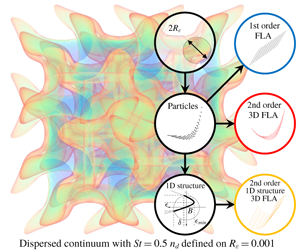Article contents
A model for the investigation of the second-order structure of caustic formations in dispersed flows
Published online by Cambridge University Press: 31 March 2020
Abstract

The formation of caustics by inertial particles is distinctive of dispersed flows. Their pressureless nature allows crossing trajectories resulting in singularities that cannot be captured accurately by standard Lagrangian approaches due to their fine spatial scale. A promising method for the investigation of caustics is the Osiptsov method or fully Lagrangian approach (FLA). The FLA has the advantage of identifying caustics, but its applicability is hindered by the occurrence of singularities. We present an original robust framework based on the FLA that provides an explicit expression of the dispersed phase structure that does not degenerate in the vicinity of caustics, using a single representative particle. The FLA is extended to account for the Hessian of the dispersed continuum (DC). It demonstrates the integrability of the FLA number density and allows for the calculation of the number density on a given length scale, retaining the functionality of the FLA. Number density models based on the second-order representation of the DC and on the one-dimensional structure of the particle distribution, that account for the anisotropy of the DC on caustics, are derived and applied for analytical flows. The number density is linked to a finite length scale, needed for the introduction of the FLA to spatially filtered flow fields. Finally, the method is used for the calculation of the interparticle separation on caustics. The identification of the structure of caustics presented in this work paves the way to a robust understanding of the mechanisms of particle accumulation.
JFM classification
- Type
- JFM Papers
- Information
- Copyright
- © The Author(s), 2020. Published by Cambridge University Press
References
- 6
- Cited by


